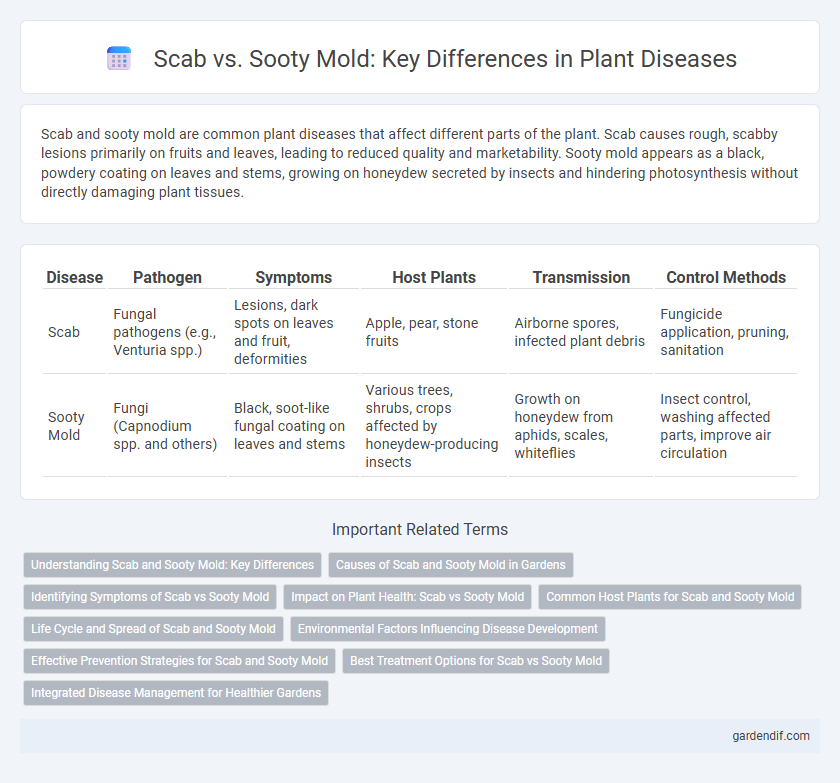
Scab vs Sooty Mold Illustration
Scab and sooty mold are common plant diseases that affect different parts of the plant. Scab causes rough, scabby lesions primarily on fruits and leaves, leading to reduced quality and marketability. Sooty mold appears as a black, powdery coating on leaves and stems, growing on honeydew secreted by insects and hindering photosynthesis without directly damaging plant tissues.
Table of Comparison
| Disease | Pathogen | Symptoms | Host Plants | Transmission | Control Methods |
|---|---|---|---|---|---|
| Scab | Fungal pathogens (e.g., Venturia spp.) | Lesions, dark spots on leaves and fruit, deformities | Apple, pear, stone fruits | Airborne spores, infected plant debris | Fungicide application, pruning, sanitation |
| Sooty Mold | Fungi (Capnodium spp. and others) | Black, soot-like fungal coating on leaves and stems | Various trees, shrubs, crops affected by honeydew-producing insects | Growth on honeydew from aphids, scales, whiteflies | Insect control, washing affected parts, improve air circulation |
Understanding Scab and Sooty Mold: Key Differences
Scab and sooty mold are distinct plant diseases with unique causes and symptoms; scab is primarily caused by fungal pathogens like Venturia inaequalis affecting fruits and leaves, resulting in rough, scabby lesions. Sooty mold develops due to fungal growth on honeydew secretions from sap-sucking insects, leading to black, powdery coatings on plant surfaces that inhibit photosynthesis. Identifying these differences is crucial for effective disease management and selecting appropriate treatment strategies.
Causes of Scab and Sooty Mold in Gardens
Scab in gardens is caused by fungal pathogens such as Venturia inaequalis on apples and Cladosporium species on other plants, thriving in damp conditions with poor air circulation. Sooty mold develops from fungi that grow on the honeydew excreted by sap-sucking insects like aphids, whiteflies, and scale insects, coating plant surfaces with a black, powdery layer. Managing humidity and controlling insect populations are critical to preventing both scab and sooty mold effectively.
Identifying Symptoms of Scab vs Sooty Mold
Scab symptoms present as rough, crusty lesions on fruit or leaves, often with raised, brownish or grayish spots that distort the surface. Sooty mold appears as a thick, black, powdery coating on leaves, stems, and fruit, developing primarily on honeydew secreted by sap-feeding insects like aphids. Distinguishing between scab and sooty mold involves noting scab's specific lesion patterns and sooty mold's superficial fungal growth without tissue distortion.
Impact on Plant Health: Scab vs Sooty Mold
Scab, caused by fungal pathogens such as Venturia inaequalis on apples, directly damages plant tissues, leading to lesions, reduced photosynthesis, and significant yield loss. Sooty mold, resulting from fungal growth on honeydew excreted by sap-sucking insects, primarily impacts plant surfaces by blocking sunlight and impairing photosynthesis but does not invade plant tissues. While scab infection often necessitates fungicide treatments to prevent crop damage, sooty mold management focuses on controlling the insect vectors to minimize mold development and its indirect effects on plant health.
Common Host Plants for Scab and Sooty Mold
Scab commonly affects apple, pear, and peach trees, causing lesions on fruits and leaves that reduce crop quality and yield. Sooty mold primarily thrives on plants like hibiscus, citrus, and guava, growing on honeydew secreted by sap-sucking insects such as aphids and whiteflies. Both diseases compromise plant health, but scab directly damages tissues while sooty mold mainly disrupts photosynthesis by covering leaf surfaces.
Life Cycle and Spread of Scab and Sooty Mold
Scab, caused by fungal pathogens such as Venturia inaequalis, primarily spreads through airborne spores released during wet conditions, infecting leaves and fruit in spring and summer. Sooty mold develops on plant surfaces by colonizing honeydew secreted by sap-sucking insects like aphids, spreading mainly through wind and insect movement. The scab fungus overwinters in fallen leaves, while sooty mold depends on the continuous presence of honeydew for its life cycle progression.
Environmental Factors Influencing Disease Development
Scab disease thrives in warm, moist environments with frequent rainfall, which promotes the proliferation of fungal spores on plant surfaces. Sooty mold develops primarily in areas with abundant honeydew-producing insects, like aphids or whiteflies, creating a sticky substrate for mold growth on leaves and stems. Both diseases are influenced by environmental humidity and temperature, but scab requires direct moisture to infect, while sooty mold depends on insect activity and the presence of sugary exudates.
Effective Prevention Strategies for Scab and Sooty Mold
Effective prevention strategies for scab and sooty mold involve maintaining proper plant hygiene and monitoring environmental conditions. For scab, applying fungicides during early growth stages and removing infected plant debris reduces disease incidence. To prevent sooty mold, controlling sap-sucking insect populations like aphids and scale insects limits honeydew production, minimizing mold development.
Best Treatment Options for Scab vs Sooty Mold
Effective treatment for scab, a fungal disease caused by Venturia species, involves the application of fungicides such as captan, myclobutanil, or sulfur-based products during early leaf development and before infection periods. In contrast, sooty mold, a superficial fungal growth resulting from honeydew secreted by aphids or scale insects, is best managed by controlling the underlying insect infestation with insecticidal soaps or neem oil and washing affected plant surfaces to remove mold deposits. Integrating cultural practices like pruning for air circulation and proper sanitation enhances treatment efficacy for both scab and sooty mold control.
Integrated Disease Management for Healthier Gardens
Scab and sooty mold require distinct Integrated Disease Management (IDM) strategies to maintain healthier gardens, emphasizing prevention and early detection. Scab control focuses on pruning infected plant parts, applying fungicides during vulnerable growth stages, and selecting resistant cultivars. Effective sooty mold management involves controlling insect vectors like aphids and scale, improving air circulation, and removing black fungal growth through proper sanitation measures.
Scab vs Sooty Mold Infographic

 gardendif.com
gardendif.com